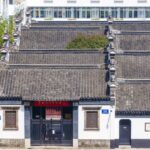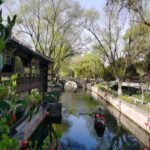The Qionghua Taoist Temple is located at the eastern end of the Dongquanmen Historical Block. It was formerly known as the Fanli Taoist Temple. It is a small scenic spot that can be visited casually when passing by. It is famous for the qionghua flowers planted in the temple. Usually, there are not many tourists. However, from April to May, when the flowers are in full bloom, it is crowded with people. Learning about the history of the Taoist temple and the stories of the ancients and the qionghua flowers will make you feel that it has a mysterious color. The Qionghua Taoist Temple was built in the Han Dynasty. Most of the buildings seen now are rebuilt in modern times. There are three characters ‘Fanli Taoist Temple’ written on the memorial arch at the entrance of the Taoist temple. After entering the mountain gate behind the memorial arch, you can see the main hall, the Sanqing Hall. This hall was initially built by Gao Pian, the Huainan Jiedushi, in the second year of Zhonghe (882 AD) during the reign of Emperor Xizong of the Tang Dynasty. In front of the Sanqing Hall are planted ginkgo trees, Chinese pagoda trees, qionghua flowers, and old elm trees. Although the qionghua flowers are no longer the original ones from the past, it does not hinder the enthusiasm of tourists to come and enjoy the flowers. When the qionghua flowers are in full bloom, each cluster has eight small flowers surrounding the middle stamen, just like a white jade plate, very beautiful. The garden behind the Sanqing Hall is small and exquisite. The Qionghua Terrace inside is related to the down-and-out story of Wu Jingzi, the author of ‘The Scholars’, in his later years. The standing pavilion originated from the Wushuang Pavilion built by Ouyang Xiu beside the qionghua flowers. In addition, there is also a relic of an ancient well named Yugou in the Taoist temple. Sometimes, calligraphy and painting exhibitions are held in the Qionghua Taoist Temple. And it is close to Yangzhou No. 1 Middle School. Sometimes, the sound of reading can be heard, full of literary atmosphere. Entering from the alley to the west of the Qionghua Taoist Temple can lead to the Dongquanmen Historical Block. 300 meters north of Dongquanmen is the Dongguan Street Historical Block, which can be visited together. Opening hours: Open all year round from 8:00 to 18:30.
Qionghua Taoist Temple
The Qionghua Taoist Temple is located at the eastern end of the Dongquanmen Historical Block. It was[...]









